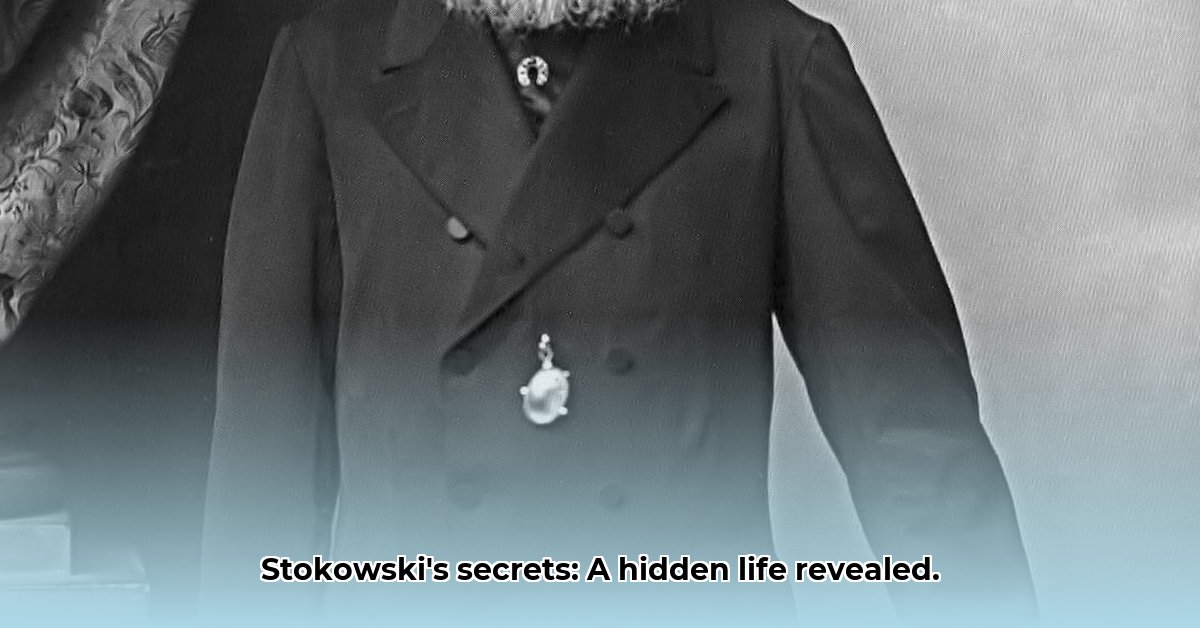Ever wondered about the life of Leopold Stokowski, the legendary conductor who changed how we hear orchestral music? This isn’t just a dry recitation of facts; it’s a journey into the fascinating, sometimes mysterious, story of his upbringing and education. We’ll tackle some tricky bits—like the conflicting stories about where and when he was born—to paint a fuller picture of the man. We’ll also explore who influenced him, how he developed his unique sound, and how his education helped him become a musical revolutionary who made classical music accessible to everyone. For more details on his background, check out this link to Stokowski’s background. Get ready for a captivating look at a truly remarkable figure.
Leopold Stanislaus Stokowski’s Education: A Biographical Exploration
The life and education of Leopold Stokowski, one of the most influential conductors of the 20th century, remains surprisingly shrouded in mystery, adding to his already enigmatic persona, creating a captivating exploration of his journey. While we know he achieved mastery of the musical world, the specifics of his path are far from crystal clear. It’s like trying to piece together a jigsaw puzzle with some key pieces missing – a challenge that only heightens the intrigue.
The Puzzling Early Years and Musical Training
Even pinpointing Stokowski’s birthdate and birthplace is tricky, presenting a complex challenge. His birth certificate gives his birth date as April 18, 1882, in London. However, on occasion, Stokowski gave his year of birth as 1887 instead of 1882, as in a letter to the Hugo Riemann Musiklexicon in 1950, which also incorrectly gave his birthplace as Kraków. Nicolas Slonimsky, editor of Baker’s Biographical Dictionary of Musicians , received a letter from a Finnish encyclopaedia editor that said, “The Maestro himself told me that he was born in Pomerania, Germany, in 1889.” These discrepancies aren’t simple mistakes; they suggest a deliberate vagueness, perhaps intentional, perhaps simply lost to time. This early ambiguity sets the stage for a life that was, to say the least, unconventional.
We know he displayed musical talent from a young age, learning piano, organ, and composition. But exactly where he learned these skills, and from whom, remains largely unknown. It’s a tantalizing mystery that makes you wonder about his early influences and how they shaped his future. Did he learn from formal teachers, or was he largely self-taught? The exact details are currently beyond our grasp. Ongoing research might one day shed light on these early formative years.
Formal Training: A Glimpse into the Process of Musical Direction
While the specifics remain obscured, Stokowski undoubtedly received some formal musical training. He studied at the Royal College of Music in London, where he enrolled in 1896 at the age of thirteen, making him one of the youngest students to do so, and later attended The Queen’s College, Oxford, where he earned a Bachelor of Music degree in 1903. These institutions provided him with a solid foundation in musical theory and technique. However, some experts believe his genius transcended mere formal education. Many hypothesize his natural talent and relentless self-study were equally, if not more, influential in forming his unique style.
Stokowski wasn’t just a student; he was an insatiable learner, constantly diving into musical scores and exploring different compositional techniques. He clearly embraced self-education alongside formal training. This blend of structured learning and independent exploration paints a picture of a musician driven by an intense curiosity and a relentless passion for his craft.
Beyond the Classroom: Shaping a Musical Vision and Interpretation
Stokowski’s education wasn’t restricted to formal institutions. His time in England, followed by his move to New York and later Philadelphia, exposed him to diverse musical landscapes and traditions. These experiences were undoubtedly formative, shaping his perspective and broadening his artistic horizons. In 1905, Stokowski began work in New York City as the organist and choir director of St. Bartholomew’s Church. He was very popular among the parishioners, who included members of the Vanderbilt family.
Collaborations with countless musicians and his experiences conducting various orchestras left an indelible mark on his style. One particularly important influence was his first wife, Olga Samaroff, a renowned pianist. She wasn’t only a personal influence; she likely played a major role in shaping his public image and career progression. For professional and career reasons, she “urged him to emphasize only the Polish part of his background” once he became a resident of the United States. It’s clear that his “education” extended far beyond academic settings, encompassing both artistic and personal growth.
Stokowski’s approach to music was revolutionary. Late in the 1929–1930 symphony season, Stokowski started conducting without a baton. His free-hand manner of conducting soon became one of his trademarks. He also experimented with new lighting arrangements in the concert hall, at one point conducting in a dark hall with only his head and hands lighted, at other times arranging the lights so they would cast theatrical shadows of his head and hands. He famously eschewed the traditional baton in his conducting style, innovating in orchestral arrangements and concert staging. He encouraged “free bowing” from the string section, “free breathing” from the brass section, and continually altered the seating arrangements of the orchestra’s sections, as well as the acoustics of the hall. This experimental spirit, this drive to push boundaries, was arguably as much a part of his “education” as any formal classroom training. He redefined what it meant to be an orchestral conductor.
A Legacy That Transcends the Unknown and Musical Innovation
The uncertainties surrounding Stokowski’s early life and education only add to the captivating mystery of his persona and achievements. While pinpointing precise details may prove impossible, the lasting impact of his work is undeniable. He fundamentally altered the sound and presentation of orchestral music, making classical music more accessible to a wider audience, and leaving an enduring legacy on generations of musicians.
His innovations, his unique conducting style, and his contributions to the art of orchestration far outweigh any gaps in our knowledge of his early years. The story of Leopold Stokowski’s education is not merely a chronicle of formal schooling; it’s a testament to how innate talent, unwavering self-discipline, and a relentless pursuit of artistic excellence can produce a truly remarkable legacy. It’s a story that continues to inspire, even with some of its pages still missing.
How to Analyze Leopold Stokowski’s Unique Conducting Techniques
Key Takeaways:
- Stokowski’s conducting style prioritized emotional impact over strict adherence to the score, revolutionizing interpretations.
- His batonless technique and innovative orchestral arrangements were revolutionary, influencing modern conducting.
- Analyzing his work requires examining both his artistic genius and the controversies surrounding his interpretations.
- Understanding his education and background illuminates his unique approach, giving insight into his motivations.
- Sources disagree on details of his early life, adding to his enigmatic nature and complicating biographical studies.
The Enigmatic Early Life and Its Musical Impact on Symphony Orchestras
Unraveling the life of Leopold Stokowski is like piecing together a fragmented musical score. Even foundational facts, like his exact birthdate and birthplace, remain debated by scholars. This ambiguity, however, is revealing. It speaks volumes about the man’s guarded nature and his deliberate cultivation of an enigmatic persona. Oliver Daniel’s 1000-page biography Stokowski – A Counterpoint of View (1982), reveals Stokowski came under the influence of his first wife, American pianist Olga Samaroff, who urged him to emphasize only the Polish part of his background once he became a resident of the United States. How did this mystery influence his conducting style? Did his elusive past translate into a revolutionary musical present?
His early musical training, while well-documented in its later stages, remains somewhat obscure in its origins. This lack of clarity fuels speculation about his early development. Did this early ambiguity shape his later willingness to challenge musical norms? Was it a contributing factor to his bold, unconventional interpretations? These questions shape how to analyze Leopold Stokowski’s unique conducting techniques.
A Technique Beyond the Baton: The Art of Musical Expression
Stokowski’s most striking characteristic was his abandonment of the traditional baton. This seemingly simple act represented a radical departure from established practice. What did it signify? It symbolized a break from rigid adherence to the traditional methods. His fluid, expressive movements, often without a baton, invited a degree of freedom and spontaneity previously unheard of in orchestral performance. His conducting was less about precise instructions and more about creating an atmosphere, evoking emotion and painting a sonic landscape. This visual element became an integral part of the performance itself, enhancing the audience experience.
By watching his performances, we can analyze his gestures. Were they fluid and expansive? Did they mimic the ebb and flow of the music? Did they emphasize certain melodic lines or harmonic progressions? Analyzing his technique requires careful observation and understanding of the visual language he employed.
Orchestral Re-Imagining: A Double-Edged Sword of Musical Innovation
Stokowski’s approach went beyond mere interpretation. He re-orchestrated scores extensively, often altering instrumentation, adding or subtracting parts, modifying dynamics, and even altering the melodic line itself. This sparked significant debate in the classical music community. Some celebrated the richness and new soundscapes he created; others criticized his departures from the composer’s original vision.
How to analyze Leopold Stokowski’s unique conducting techniques in this context requires a balanced perspective. We need to consider both the creative merits of










